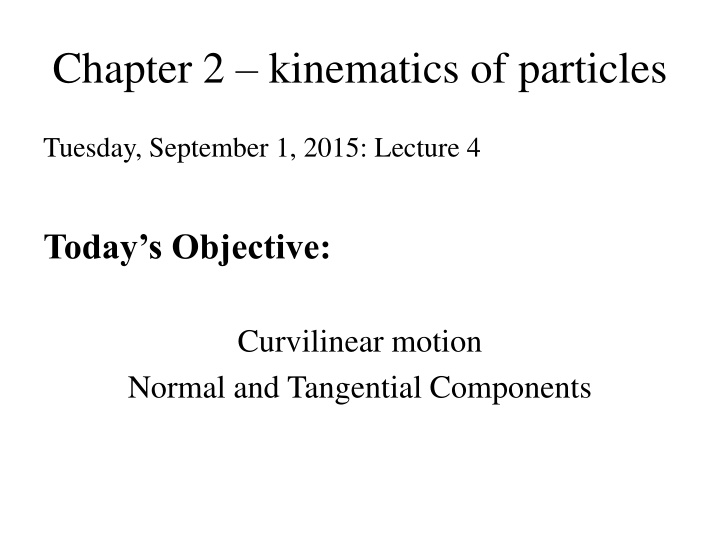
Curvilinear Motion: Normal and Tangential Components Explained
Dive into the intricacies of curvilinear motion with a focus on the normal and tangential components. Learn about the complexities of velocity, acceleration, and coordinate systems in dynamic particle motion.
Download Presentation

Please find below an Image/Link to download the presentation.
The content on the website is provided AS IS for your information and personal use only. It may not be sold, licensed, or shared on other websites without obtaining consent from the author. If you encounter any issues during the download, it is possible that the publisher has removed the file from their server.
You are allowed to download the files provided on this website for personal or commercial use, subject to the condition that they are used lawfully. All files are the property of their respective owners.
The content on the website is provided AS IS for your information and personal use only. It may not be sold, licensed, or shared on other websites without obtaining consent from the author.
E N D
Presentation Transcript
Chapter 2 kinematics of particles Tuesday, September 1, 2015: Lecture 4 Today s Objective: Curvilinear motion Normal and Tangential Components
Plane Curvilinear Motion: Velocity Note the direction of acceleration. It s not predictable!
Acceleration Note: The curve isn t the path of the particle, it s a plot of the velocity!
Normal and Tangential Coordinates Used when Motion is along a curve n-t coordinates are most effective ds = d , ds/dt = d /dt = v
Normal and Tangential Coordinates From Fig 2, as dv approaches 0, the direction of dv becomes perpendicular to the tangent a = v det/dt + dv/dt et Fig 1 The second term on the r.h.s. represents acceleration component in the tangential direction In the 1st term on RHS, et has a magnitude of 1, but the direction is changing with the motion, so this is not a constant vector and det/dt 0 Fig 2
Normal and Tangential Coordinates Let us find what is det/dt det = d (et = 1) en det/dt= d /dt en The direction of et is along the tangent to the curve, where as, det points toward the center of the curve. det/dt = angular velocity (d /dt) x en = (w?)en =?/?en d /dt = angular velocity of the particle = w = v/
Normal and Tangential Coordinates Circular Motion a = v det/dt + dv/dt et = (v) (v/ ) en + dv/dt et = v2/ en + atet a = anen +atet For a circular motion, v = r ?? Or d?/?? = v/r ?? ? ??? ? ??? ???? ?????? ????????
Problem 2. 101 Given: N = 45 rpm. Find v and a of point A.
Problem 2.122 Given: The particle P starts from rest at point A at time t = 0 and changes its speed thereafter at a constant rate of 2g as it follows the horizontal path as shown. Determine the magnitude and direction of its total acceleration: a. Just after point B, and b. At point C
